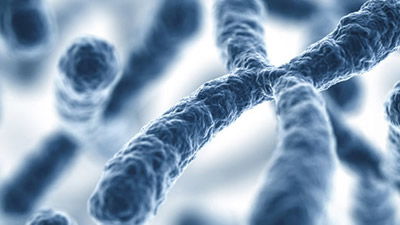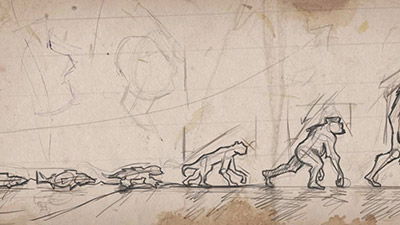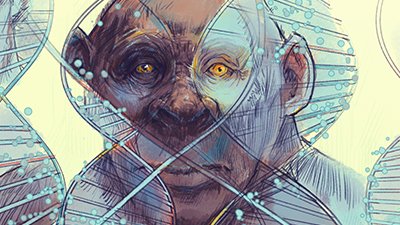
Kin Confusion
For all the years of proclaiming chimpanzees as our closest living evolutionary cousins, some evolutionists think we may actually be more closely related to orangutans.
News Source
- National Geographic News: “Orangutans May Be Closest Human Relatives, Not Chimps”
Scientists John Grehan of New York’s Buffalo Museum of Science and Jeffrey Schwartz of the University of Pittsburgh are behind the new hypothesis. They argue that the genetic evidence most evolutionists use to support a close chimp–human connection is flawed.
They argue that the genetic evidence most evolutionists use to support a close chimp–human connection is flawed.
Grehan and Schwartz would replace chimps with orangutans, which they believe more closely resemble humans and which (to them) further negates the genetic comparisons between humans and chimpanzees. The duo claim humans share 28 unique physical characteristics with orangutans, versus seven with gorillas and only two with chimpanzees.
Among the shared characteristics between orangutans and humans are “thickly enameled molar teeth with flat surfaces, greater asymmetries between the left and right side of the brain, an increased cartilage-to-bone ratio in the forearm, and similarly shaped shoulder blades,” reports National Geographic News. Schwartz further names a hole in the roof of the mouth, the widest-separated mammary glands [of primates], and the longest hair.
Some of the traits were also matched up with ape fossil remains from Africa and Europe, distant from modern orangutans’ home in Southeast Asia. The scientists believe an ancient, orangutan-like ancestor of humans lived in Africa, Asia, and Europe, with one population eventually giving rise to modern humans while the others evolved in isolation.
Of course, such revolutionary thinking in evolutionary anthropology is ruffling plenty of feathers. “There are many paleontologists and molecular biologists who are heaping scorn on this paper,” said Peter Andrews of London’s Natural History Museum. He added, “It is controversial,” but continued, “I think it is a subject that needed to be aired.”
Grehan and Schwartz rail against the idea that genetic similarities between chimps and humans prove their evolutionary closeness.
Grehan and Schwartz rail against the idea that genetic similarities between chimps and humans prove their evolutionary closeness. “When you’re doing a really rigorous analysis of relationships, you don’t just stop at the potential demonstration of similarity. You have to distinguish between features that are widely shared [i.e., among many organisms] and those that are more uniquely shared [between two organisms],” Schwartz explained. He and Grehan believe the reported 96-percent similarity between chimp and human genomes ignores the fact that the data includes such widely shared traits.
The researchers further note that such genetic similarity studies are based on the coding region of the genome, which constitutes only three percent or less of an animal’s DNA. Unsurprisingly, that claim doesn’t faze evolutionist who steadfastly support the chimp–human connection on the basis of other genetic studies.
What is interesting to us is, first, that the evolutionary evidence doesn’t all line up. Our genome appears closer to a chimp’s; our anatomy appears closer to an orangutan’s. The contradictory evidence reminds us that design is a better explanation for similarities. Design can account for such anomalies, whereas evolution cannot. Not only that; in both cases, the similarity is only of “appearance”—one must presuppose evolution to see an evolutionary explanation for such similarities.
The second point of interest to us is these evolutionists’ attack on genetic studies as evidence of close evolutionary relationships. Statistics of chimp–human genetic likeness are often paraded around by news reports as ipso facto evidence that we “really did” share a common ancestor with apes. But Arizona State expert Malte Ebach, commenting on the research, adds:
They criticize molecular data where criticism is due. Palaeoanthropology is based solely on morphology, and there is no scientific justification to favor DNA over morphological data. Yet the human–chimp relationship, generated by molecular data, has been accepted without any scrutiny.1
Hearing evolutionists themselves attack the weaknesses of such genetic implications saves us the trouble!
In related news, a Chinese fossil has been demoted from apeman status after 15 years.2 National Geographic News reports on anthropologist Russell Ciochon’s change of mind after he originally classified the fossil as an unknown form of early human because it “didn’t fit in any category of hominin . . . and it also didn’t fit into any ape category.”
Ciochon first believed the fossil was more primitive than Homo erectus, instead perhaps an independent line of human ancestors that evolved in Asia. But new evidence in the last decade suggests the fossil is similar to what is thought to be the fossil of an “orangutan ancestor.”
This story reminds us of the role of speculation in anthropology and other historical sciences. Comparing sparse fossils requires much guesswork and elevates the role of interpretation and the presupposition of evolution, both of humans specifically and all organisms generally. Which brings us to two final related news items. The first concerns Ignacius graybullianus, the supposed cousin of one of our evolutionary ancestors.3 The second concerns Eritherium azzouzorum, said to be the oldest known elephant ancestor because “two of the creature’s lower front teeth jut a fraction of an inch out from its jaw.”4 Thus (says one scientist), “This is some kind of precursor of the tusk of the more modern [elephant].”
It sounds like plenty of guesswork and interpretation are going into those conclusions as well!
Further Reading
- Are Humans and Chimps Related?
- Did Humans Really Evolve from Apelike Creatures?
- Get Answers: Ape-Man, Missing Links, and Fossils
For More Information: Get Answers
Remember, if you see a news story that might merit some attention, let us know about it! (Note: if the story originates from the Associated Press, FOX News, MSNBC, the New York Times, or another major national media outlet, we will most likely have already heard about it.) And thanks to all of our readers who have submitted great news tips to us. If you didn’t catch all the latest News to Know, why not take a look to see what you’ve missed?
(Please note that links will take you directly to the source. Answers in Genesis is not responsible for content on the websites to which we refer. For more information, please see our Privacy Policy.)
Footnotes
- “Humans Related to Orangutans, Not Chimps,” Phys.org, June 18, 2009, https://phys.org/news/2009-06-humans-orangutans-chimps.html.
- Brian Handwerk, “Early ‘Human’ Is Ape After All, Discover Decides,” National Geographic News, June 17, 2009, http://news.nationalgeographic.com/news/2009/06/090617-early-human-ape-mystery.html.
- University of Florida, “54-million-year-old Skull Reveals Early Evolution of Primate Brains,” ScienceDaily, June 23, 2009, https://www.sciencedaily.com/releases/2009/06/090622171359.htm.
- Mark Anderson, “Rabbit-size Elephant Ancestor Found—Oldest Known,” National Geographic News, June 23, 2009, http://news.nationalgeographic.com/news/2009/06/090623-rabbit-elephant-oldest.html.

Answers in Genesis is an apologetics ministry, dedicated to helping Christians defend their faith and proclaim the good news of Jesus Christ.
- Customer Service 800.778.3390
- Available Monday–Friday | 9 AM–5 PM ET
- © 2025 Answers in Genesis



